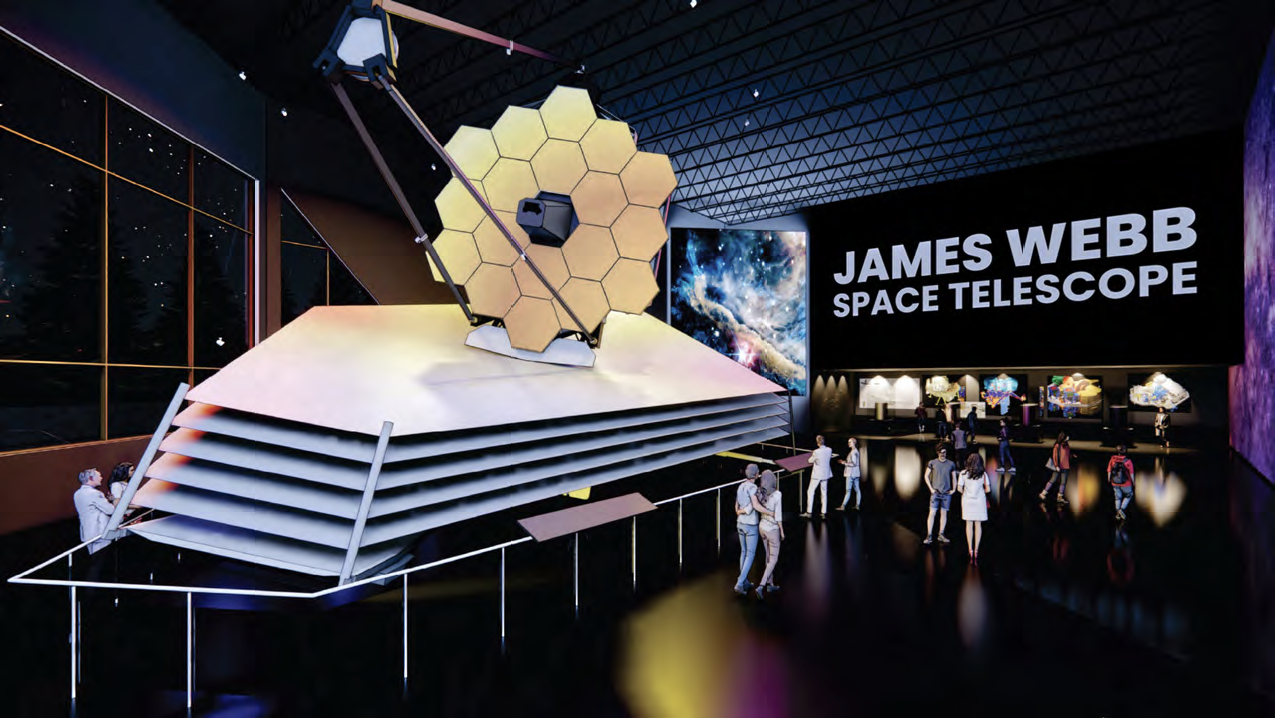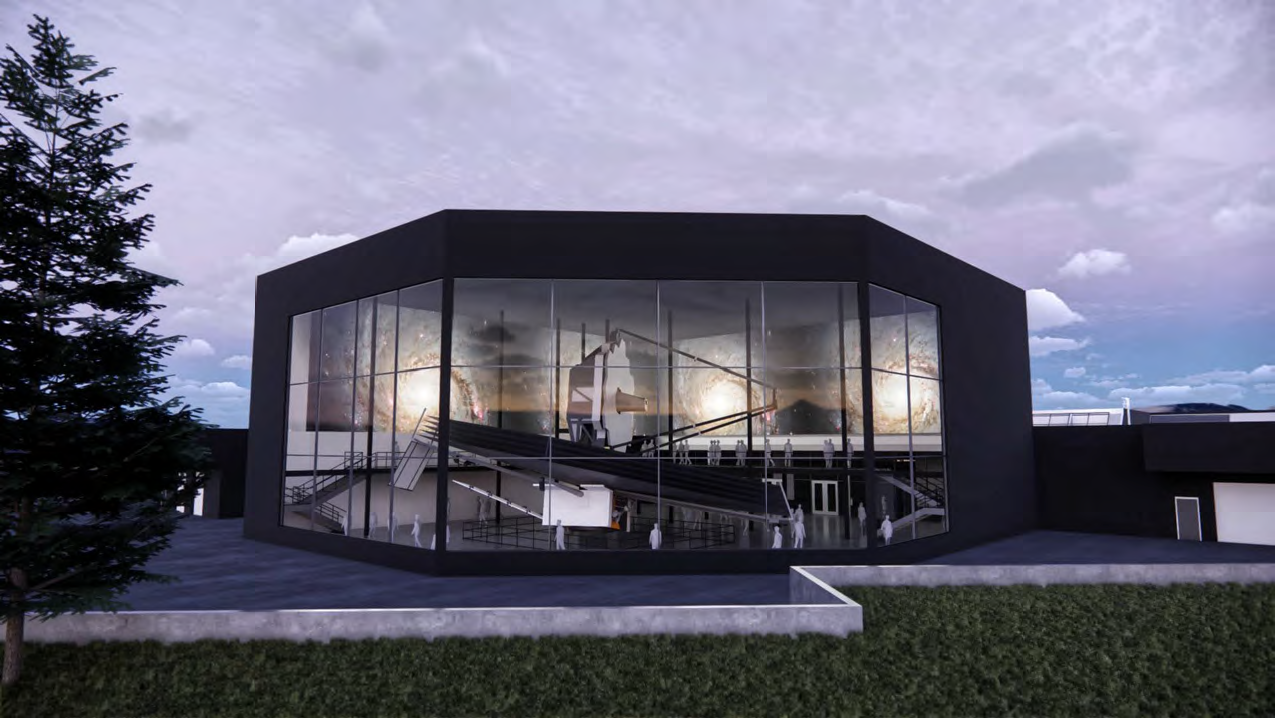Terry Bramschreiber, Director of Space Foundation Discovery Center and Accreditation, Space Foundation
For the last two years, scientists have used the James Webb Space Telescope (“James Webb”) to explore our universe and bring back pictures that astound, perplex and delight.

Artistic rendition of the James Webb Space Telescope
model within the Space Foundation Discovery Center
On Christmas Day 2021, NASA gave the world a gift. The James Webb Space Telescope (Webb) was launched from French Guiana and, after successfully navigating through 344 potential single point failures, settled into its orbit 30 days later. Ever since its conspicuous, primary mirror unfolded and the telescope began sending data, the scientific community has been awestruck. The images that have come back are not only breathtaking but are changing the way we think about the universe. That fact alone justifies the investment and effort of the Webb mission. However, the curiosity that is ignited in young minds may prove to have provided an even more powerful gift for generations.
Many people in today’s space community came of age in the Hubble Space Telescope era. If you were to ask someone to think about an image from outer space, chances are high they would recall an image taken by the Hubble. Whether it is an image of the “Pillars of Creation” nursery of stars or the “Deep Field” image that showed there were thousands of galaxies residing in an observation area the equivalent to holding the head of a pin at arm’s length, the Hubble images have made distinct impressions, scientifically and culturally. From books, movies and television shows to artwork, postage stamps, clothing and coins, Hubble has become a part of human culture worldwide. Impacts like those are transformational for generations.
The James Webb Space Telescope will undoubtedly do the same. While Hubble is still active and expected to remain functional until at least 2035, the torch of inspiration has effectively been passed. Webb can cut through the dust and gas that obscured Hubble’s view. It takes us back further in time to see the first galaxies forming and is challenging several long-held notions of cosmology. But one doesn’t need to be an astronomer to appreciate the beauty of a nebula, the chaos of a black hole, or the enormous scale of the universe.
Curiosity and inspiration transcend age, education level, language and culture. This is the power of space imagery. The adults that will someday work in the global space ecosystem are currently the kids that are being inspired by Webb images to study science, technology, engineering, and mathematics (STEM).
_________________________________________
A Model for the Space Community
________________________________
To ensure the space economy continues to thrive, we have the opportunity — if not the responsibility — to feed the interests and passions of young people. For the very young, we should encourage inquiry and curiosity about the natural world. Allow children to ask questions and play with open-ended problems. As they are introduced to the rules of science, we can teach them how we know what we know. We can explain what the discipline of science has known for centuries — that mistakes are part of the learning process, and weak theories are replaced by better ones. There usually is not “truth” but only an explanation that is the best we currently have with the evidence we have gathered. We must introduce the concept that mathematics is the language of science. Allow them to design, build and test. We can empower and encourage kids to pursue intellectually rigorous disciplines. STEM courses can be difficult but can also be fun and satisfying at the same time. The James Webb Space Telescope can help with all these pursuits.
While images can capture the imagination of the viewer, an artifact does even more. Looking at a drawing of a dinosaur can be exciting, but it is nothing compared to staring into the powerful jaws of a fossil Tyrannosaurus rex. This is precisely why Space Foundation Discovery Center in Colorado Springs has accessioned the world’s only full-scale model of the James Webb Space Telescope. When fully assembled, the model is three stories tall and as large as a tennis court, making it an object of even more awe. Seeing your own reflection in a display of one of its gold-plated mirrors makes you feel like you have been transported one million miles away from Earth. The same tool that can peer 13.5 billion years in the past can also reflect your face in the present time. This paradoxical experience can make you feel like an insignificant blip in the ether while simultaneously making you feel that you are deeply connected to the universe through space and time.
By sharing the model, its continuous discoveries, and all of the science and talent that make it possible, our objective is to set children on a path that begins with a feeling of awe and wonder; grow their curiosity, inquiry and knowledge; and continue that passion, inspiration and action for a lifetime. As the Discovery Center looks to build a new facility to house this incredible artifact, we are creating educational programming under the advisement of astronomers, programmers and engineers that have worked on the Webb mission. We strive to inspire students around the world, in-person and virtually.

Artistic rendition of the James Webb Space Telescope on
display within the Space Foundation Discover Center.
Inspiring young people to pursue space and STEM education is commendable in its own right but is also necessary for our collective future in space. While talented people in all disciplines are needed, STEM is essential for the next generation in the global space community. We need knowledgeable scientists who understand the appropriate evidence to seek and how to measure it; programmers who can ensure instruments in space can collect and send data; creative engineers who can solve problems such as how to tuck an enormous telescope into a small nose cone; and mathematicians who can identify the orbital mechanics to keep spacecraft in orbit around the sun. The space ecosystem will only continue to thrive if we continue to inspire young people today. Who will be among the next generation of space innovators and explorers? Who are the scientists and engineers who will stand on the shoulders of the giants who came before them and see a bit further?

The space program has had its fair share of unforgettable, inspirational moments — the first man in space, the first steps on the moon, landing rovers on Mars, and many others. Today’s students are having their own “Hubble moment” just as many of us did over the last 30 years. Space Foundation Discovery Center, harnessing the James Webb Space Telescope’s ability to generate wonder, curiosity and intrigue, hopes to cultivate more of these moments. As Webb gazes deep into our past, we use it to impact our future.

Terry
Bramschreiber
Terry Bramschreiber is the director of Space Foundation Discovery Center and Accreditation. Bramschreiber, or “Dr. Bram,” joined Space Foundation in 2021 and has been active as a Space Foundation Teacher Liaison since 2006. He is also a NASA Solar System Ambassador. Dr. Bram spent 27 years in public education as a science teacher, coach, mentor teacher, dean of students, assistant principal, educational consultant, district site plan facilitator, and high school principal. He has a master’s degree in secondary science education from Colorado College and a Ph.D. in curriculum and instruction from the University of Denver. Dr. Bram is a published author and has presented teacher professional development across the country. For more information on Space Foundation, please visit
www.SpaceFoundation.org, and follow us on Facebook, X, Instagram, LinkedIn and YouTube.
discoverspace.org

